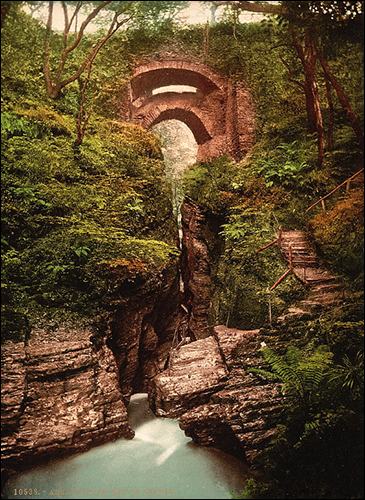River Mynach (MY-nick or MY-knock) runs through a beautiful, wooded area in Wales and forms a very deep ravine. There are glorious water falls at one point of the ravine, dropping 300 feet (90 meters). Swift, white water flows at the bottom of the falls which flow throw several sharp “S” curves before it straightens out miles downstream.

A millennium or more ago, local monks built a stairway to the bottom of one side the ravine. The stairs are very steep and treacherous and are called Jacob’s Ladder. The steps allow one to view the falls and river, but do not do traveler’s much good. One cannot cross the swift river to get on the other side, and there aren’t any steps on the other side to get to the top of the falls.
Three bridges cross the river now at the falls. The three bridges are NOT side-by-side. Rather, each bridge is built above the prior bridge.

The first bridge was built sometime between the years 1075 and 1200, and I can’t be more precise than that. This first bridge was merely a narrow footbridge, built a ways down in the ravine. One had to walk down Jacob’s Ladder a bit to reach the bridge, and Jacob’s Ladder was much too narrow and steep for a horse, let alone a carriage.
The second bridge was built in 1753. It’s a stone bridge built above the original bridge. The builders of the second bridge used the first bridge to support the scaffolding. This second bridge was wider, and only a small drop from the top of the ravine, and could support horses and carriages. This second bridge was used for almost 150 years.
A third bridge, built of iron, was constructed in 1901. It was built atop both earlier bridges. It is two lanes wide and supports automobile traffic today.
Construction of the third bridge closed off access to the second bridge. If you look at the bridge from a side profile (from the photo at the top of the page), the second and third bridges look like one bridge – an iron bridge with stone sides. But the stones are from the second bridge, which was not demolished when the third bridge was constructed.
The first bridge may still be used for pedestrian traffic. One must simply walk down Jacob’s Ladder on one side, cross the bridge, then up stone stairs on the other.

If you simply drive over the bridge, you would have no idea that you are driving over the top layer of three bridges, or that you were driving over a very deep gorge.
The bridge is called Pontarfynach (“Pon-TAR-fee-nach”) in Welsh, which means “The Bridge on the Mynach”. But it is known in English by an entirely different name.
The bridge is named after the builder of the bridge, and this is the story.
